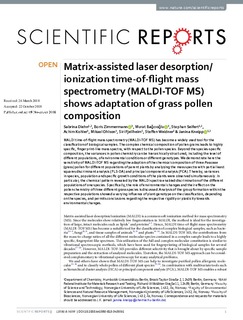| dc.contributor.author | Diehn, Sabrina | |
| dc.contributor.author | Zimmermann, Boris | |
| dc.contributor.author | Bagcioglu, Murat | |
| dc.contributor.author | Seifert, Stephan | |
| dc.contributor.author | Kohler, Achim | |
| dc.contributor.author | Ohlson, Mikael | |
| dc.contributor.author | Fjellheim, Siri | |
| dc.contributor.author | Weidner, Steffen | |
| dc.contributor.author | Kneipp, Janina | |
| dc.date.accessioned | 2019-04-03T12:39:15Z | |
| dc.date.available | 2019-04-03T12:39:15Z | |
| dc.date.created | 2018-12-02T23:14:42Z | |
| dc.date.issued | 2018 | |
| dc.identifier.citation | Scientific Reports. 2018, 8 (1), . | nb_NO |
| dc.identifier.issn | 2045-2322 | |
| dc.identifier.uri | http://hdl.handle.net/11250/2593179 | |
| dc.description.abstract | MALDI time-of-flight mass spectrometry (MALDI-TOF MS) has become a widely used tool for the classification of biological samples. The complex chemical composition of pollen grains leads to highly specific, fingerprint-like mass spectra, with respect to the pollen species. Beyond the species-specific composition, the variances in pollen chemistry can be hierarchically structured, including the level of different populations, of environmental conditions or different genotypes. We demonstrate here the sensitivity of MALDI-TOF MS regarding the adaption of the chemical composition of three Poaceae (grass) pollen for different populations of parent plants by analyzing the mass spectra with partial least squares discriminant analysis (PLS-DA) and principal component analysis (PCA). Thereby, variances in species, population and specific growth conditions of the plants were observed simultaneously. In particular, the chemical pattern revealed by the MALDI spectra enabled discrimination of the different populations of one species. Specifically, the role of environmental changes and their effect on the pollen chemistry of three different grass species is discussed. Analysis of the group formation within the respective populations showed a varying influence of plant genotype on the classification, depending on the species, and permits conclusions regarding the respective rigidity or plasticity towards environmental changes. | nb_NO |
| dc.description.abstract | Matrix-assisted laser desorption/ionization time-of-flight mass spectrometry (MALDI-TOF MS) shows adaptation of grass pollen composition | nb_NO |
| dc.language.iso | eng | nb_NO |
| dc.relation.uri | https://www.nature.com/articles/s41598-018-34800-1 | |
| dc.rights | Attribution-NonCommercial-NoDerivatives 4.0 Internasjonal | * |
| dc.rights.uri | http://creativecommons.org/licenses/by-nc-nd/4.0/deed.no | * |
| dc.title | Matrix-assisted laser desorption/ionization time-of-flight mass spectrometry (MALDI-TOF MS) shows adaptation of grass pollen composition | nb_NO |
| dc.type | Journal article | nb_NO |
| dc.type | Peer reviewed | nb_NO |
| dc.description.version | publishedVersion | nb_NO |
| dc.source.pagenumber | 11 | nb_NO |
| dc.source.volume | 8 | nb_NO |
| dc.source.journal | Scientific Reports | nb_NO |
| dc.source.issue | 1 | nb_NO |
| dc.identifier.doi | 10.1038/s41598-018-34800-1 | |
| dc.identifier.cristin | 1638237 | |
| dc.relation.project | EC/FP7/328289 | nb_NO |
| cristin.unitcode | 192,15,6,0 | |
| cristin.unitcode | 192,15,0,0 | |
| cristin.unitcode | 192,14,0,0 | |
| cristin.unitcode | 192,10,2,0 | |
| cristin.unitname | Seksjon for realfag og teknologi | |
| cristin.unitname | Realfag og teknologi | |
| cristin.unitname | Miljøvitenskap og naturforvaltning | |
| cristin.unitname | Institutt for plantevitenskap | |
| cristin.ispublished | true | |
| cristin.fulltext | original | |
| cristin.qualitycode | 1 | |

